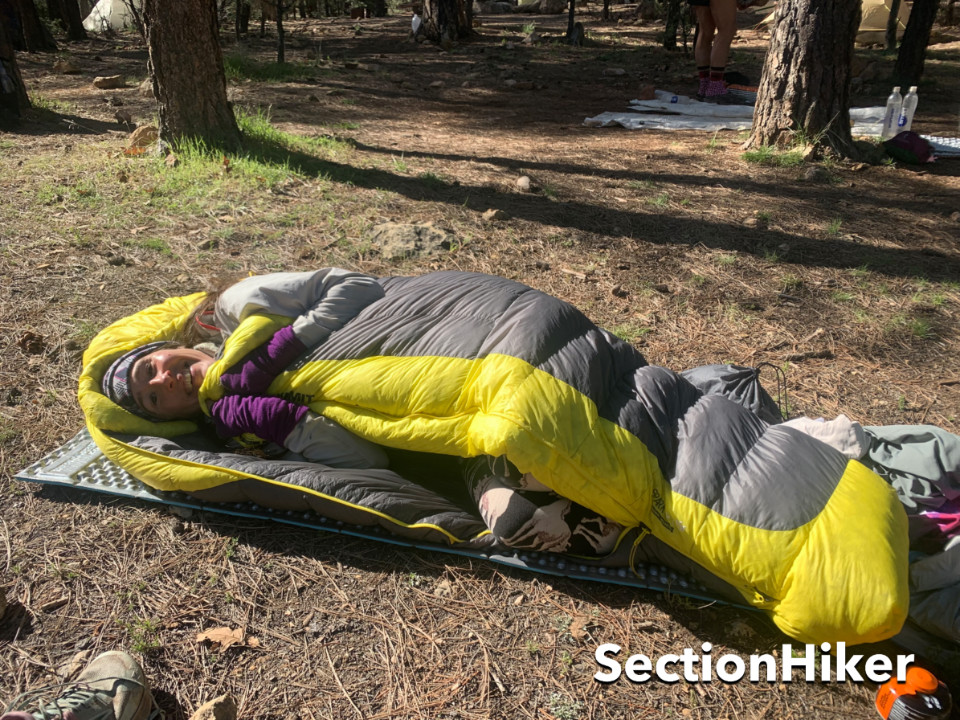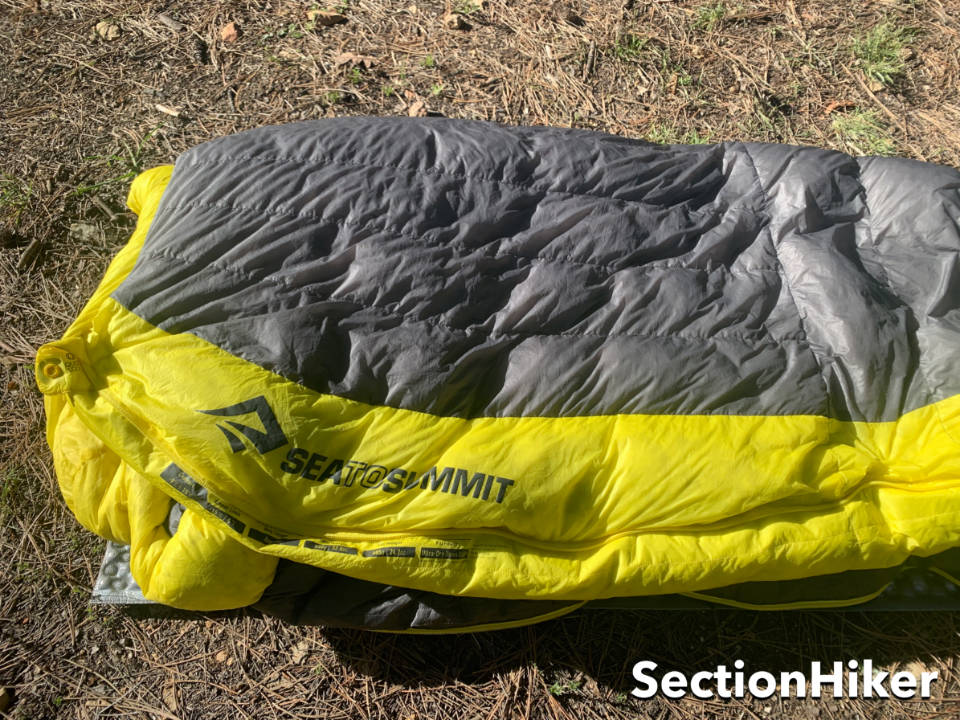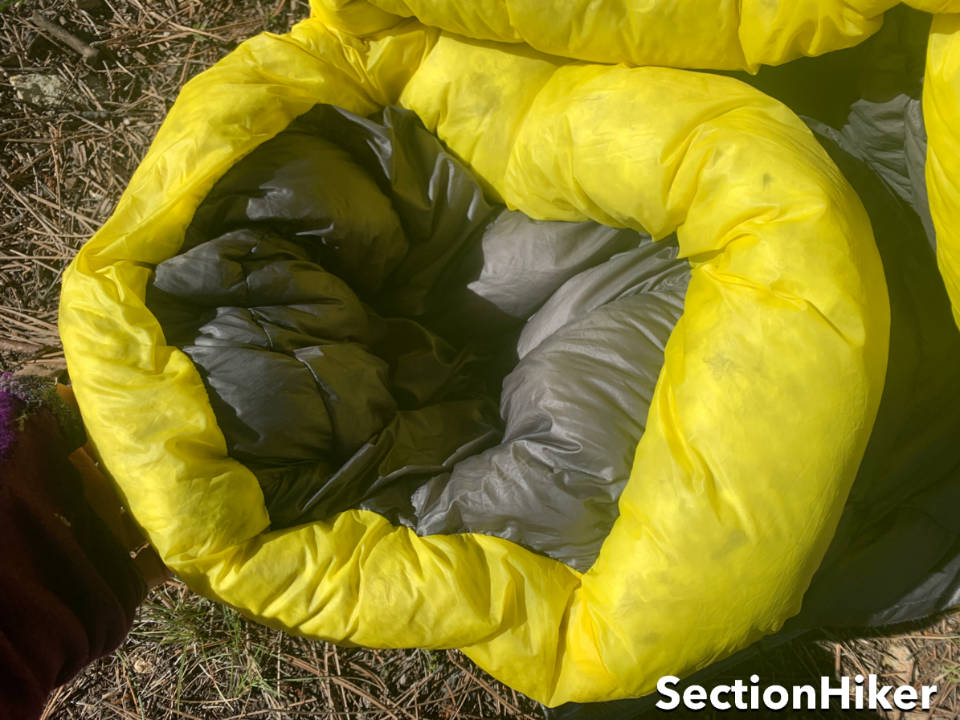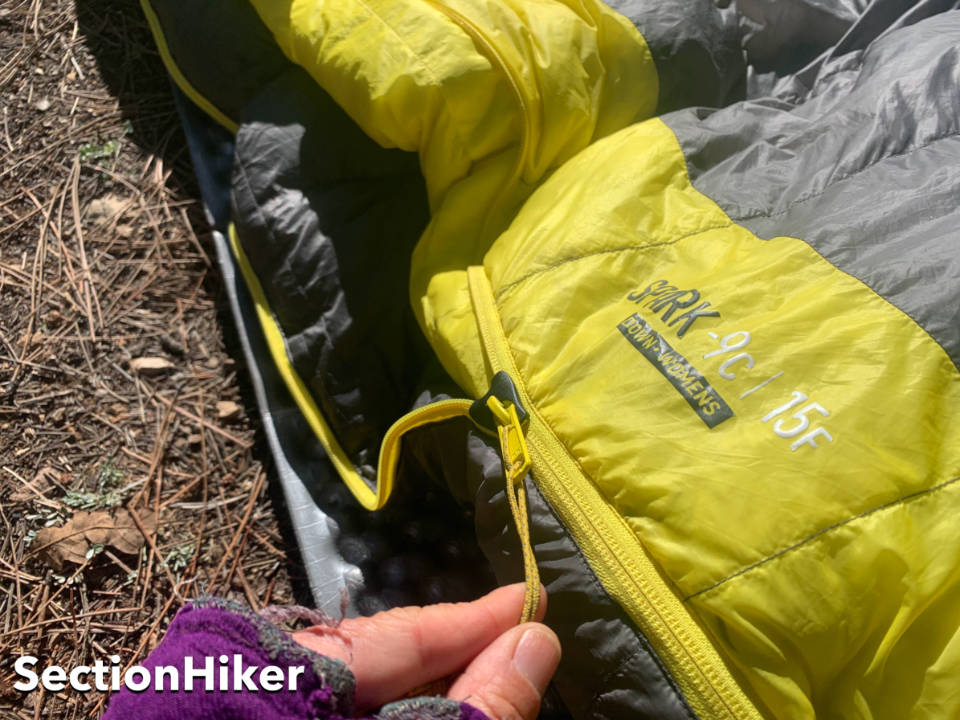The Sea to Summit Spark Women’s 15 Degree Sleeping Bag is a lightweight, 3-season sleeping bag designed for women who want comfort and quality. My body runs extremely cold, so my top priority when choosing a sleeping bag is, “Will this design keep me warm?” My second priority is twofold: how heavy the bag is and its packability. My third priority concerns durability, asking, “Will this bag hold up over time?” I tried out the Spark on my thru-hike of the Arizona Trail, where these three key factors of warmth, weight, and durability were tested. Here’s what I think.
- Temperature rating comfort: 15F
- Temperature rating lower limit: 5F
- Gender: Women’s
- Weight: 2lbs 0.8oz
- Compressed Volume: 8L
- Shape: Mummy
- Insulation: Ultra-Dry Down 850+ fill power, RDS certified
- Compression sack: included
- Shell Fabric: Ultralight 10d Nylon
- Fits Up To: 5’ 7” Regular size, (6’ 1” long size also available)
- Dimensions: (Shoulder/Hip/Feet) 55.9”/52”/36.2”
- Pros: Very warm, lightweight, packable, durable
- Cons: Narrow, snug foot box
A Sleeping Bag Engineered For Women
By nature, women tend to chill more easily than men. The Spark is designed for a woman’s specific shape to provide more warmth and insulation using body mapping to deploy insulation where it’s needed, in the foot and midsection. The shape is narrower at the shoulder and widest between the hips and knees, allowing for a natural side sleeping position. I’m a side sleeper through and through, so this worked great for me. I switch sides and wiggle at night, though, and the wider mummy shape allowed me to sleep in whatever position I wanted. The down stayed lofty and didn’t get smooshed and compressed as I shifted through my sleep, meaning I stayed toasty.

The women’s Spark is shorter overall, aiming to cut out dead space and increase thermal efficiency. This worked well for me with the narrow shoulder girth, especially when using the mummy’s insulated collar and hood. In terms of the foot box, it’s meant to minimize those nasty cold spots at the bottom of the sleeping bag by being shorter, which I could see it doing for someone closer to 5’7”. I’m not quite 5’5”, so I still tended to suffer with that little extra dead space. Even though I found the foot box snug, I still had to stuff extra clothes at the bottom to keep me warmer. I can’t say this is a design problem, but it’s more of a direct result of my height and the fact that I’m always cold!
The body-mapping design for a woman’s shape also came into play with the extra insulation using 850+ goose down. This means the bag’s chambers are filled more where you need it most. I found this to be true, and I also noted the down felt more lofty and puffy than some other sleeping bags I’ve used, which I believe helped to keep me cozier. This made me feel the quality of the Spark was high, and I appreciated this component.
Let me start by saying the Arizona Trail was cold every single night. So, I had many nights to test how the Spark fared in below or close-to-freezing temperatures. Overall, I can say it did really well, keeping me warm.
Sleeping Bag Loft and Baffles

I found the Spark lofted extremely well, which meant it didn’t take long for the fluff to return after being stuffed. It felt fluffy almost immediately after pulling it out of my stuff sack. The down insulation is 90% goose down, contributing to the bag’s warmth.
When I started researching sleeping bags years ago, I had no idea what baffles were. Baffles are those compartments running across the shell of the sleeping bag, and they’re necessary to keep the insulation from clumping or moving about. This is important because the baffles effectively reduce cold spots and decrease heat loss when insulation stays in place. The Spark has full box baffle construction for maximum warmth, accommodating extra down and minimizing those icky cold spots.
The Spark’s insulation is made with the Ultra-Dry Down waterproof treatment, which can prevent moisture from degrading the down. On the Arizona Trail, there was a lot of tent wall condensation, and even on mornings when the shell of my sleeping bag was damp, I was still warm and protected inside my burrito.
Draft Tubes, Draft Collar & Hood
To nix heat loss, the Spark has a zipper draft tube (an insulated tube running along and behind the zipper to prevent cold drafts from entering and warm air escaping). I truly valued the snuggly and poofy draft and neck collar, which is the insulated front and back collar around the hood. Most nights, I cocooned myself like a tightly wrapped burrito because of the cooler desert temps. I did this by tightening the draw cord, which stopped heat from slipping out of the bag. I felt tucked in and snug but not claustrophobic, which no one wants to feel while sleeping.

Weight & Packability
Second to warmth, the weight factor is essential to what I consider in a sleeping bag choice, based on being a thru-hiker where often every ounce counts. The regular size is 2 ½ pounds, which isn’t the lightest model on the market, but by far not the heaviest. This bag is slightly heavier than the Women’s Flame Fm IV, which the Spark replaced. However, Sea to Summit upgraded the zippers and inner liner, contributing to a slight weight increase.
When considering packability, I chose to stuff the Spark in my trusty Sea to Summit Evac Compression Dry Bag, which I’ve had since 2016, when I thru-hiked the Appalachian Trail. The Spark packed pretty well, but not the best, simply because this sleeping bag is larger in volume and substance.
Sleeping Bag Shell and Liner
The Spark’s shell fabric is 10D nylon, and the liner is 10D (D=Denier). The Flame Fm IV had a 7D liner, which is what helped the sleeping bag stay lighter. A tad heavier liner can provide more long-term durability, so I don’t mind this tradeout. This lining also good against my skin and soft.
Zippers

The top improvement I noted with the Spark were the zippers. The Flame Fm IV used lighter YKK #3 zippers, where the Spark uses the YKK #5. Sea to Summit switched to a beefier for more of a snag-free, reliable operation. My biggest complaint about the Flame Fm IV was the zippers snagging, making it tough to get in and out of my bag easily and ripping the fabric. So, of course, this was the feature I paid the most attention to while using the Spark for six weeks on trial. I’m super pleased to report I found the zippers smooth to use with no problems, never once catching.
Length & Sizing
A relevant point to make is that I’m about 5’5”, so the regular size works best for me, being suited for women up to 5’7”. There is a long size for women up to 6’ 1”, but if you’re taller than that, this wouldn’t be the ideal choice for you. Also, be sure to look at the specs at a glance above to consider your own beautifully unique and individual body shape (do you have wider shoulders or hips, for example) to see if the sizing of the Spark would work for you.
Comparable Women’s Sleeping Bags
Recommendation
I highly recommend Sea to Summit’s Spark Women’s 15-Degree Sleeping Bag for any woman who values a bag that emphasizes warmth, light weight, and durability. It’s a solid option for cold sleepers like me, and it handled well for those freezing and close-to-freezing nights in the desert. If you hike hard and want to sleep hard, too, the Spark is a solid choice for a quality sleeping bag engineered for women
Disclosure: Sea-to-Summit donated a bag for review.
SectionHiker is reader-supported. We only make money if you purchase a product through our affiliate links. Help us continue to test and write unsponsored and independent gear reviews, beginner FAQs, and free hiking guides.
